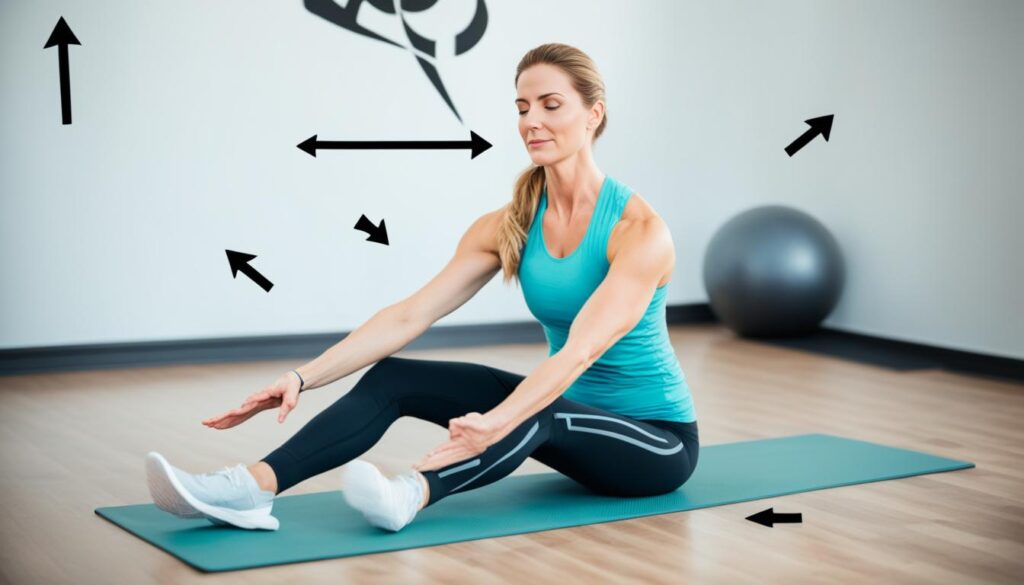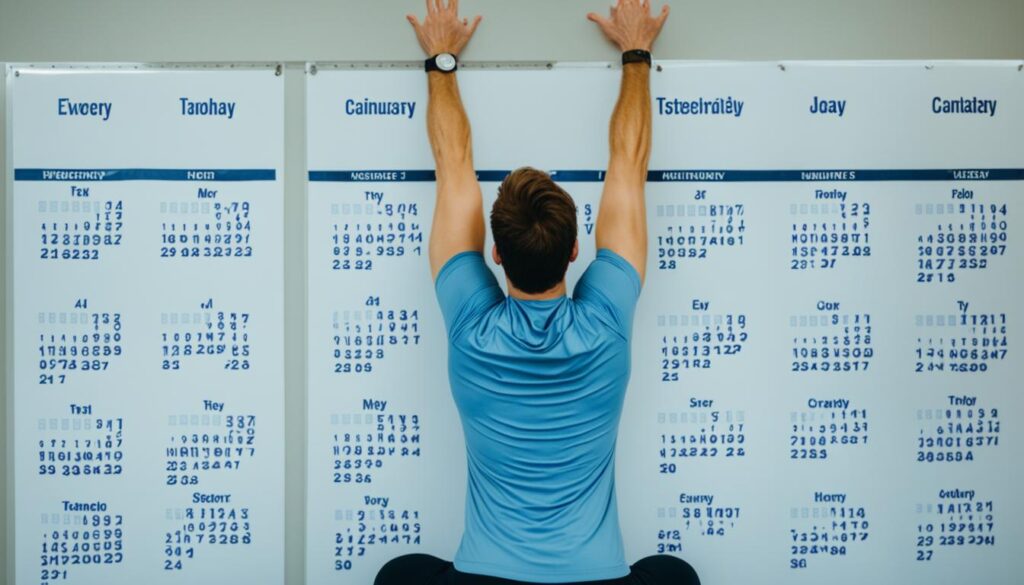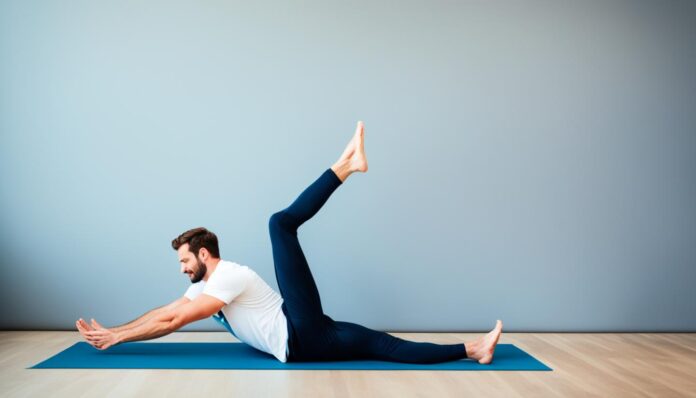Are you looking to enhance your athletic performance, reduce the risk of injury, and improve your overall mobility? Look no further than the power of stretching exercises. Stretching is a crucial component of any well-rounded fitness routine, offering a myriad of benefits that can help you reach your fitness goals. In this comprehensive guide, we’ll explore the secrets to improving your flexibility and unlocking a new level of physical prowess.
Stretching not only increases your range of motion but also helps prepare your body for physical activity, reducing the likelihood of strains and other injuries1. By incorporating regular stretching into your routine, you can unlock a host of advantages that will elevate your athletic performance and daily life.
Key Takeaways
- Stretching improves flexibility and range of motion
- Proper stretching techniques are essential to prevent injuries
- Consult with a professional for personalized stretching programs
- Warm-up before stretching to enhance effectiveness and safety
- Incorporate a variety of stretching exercises to target all major muscle groups
Importance of Flexibility and Stretching
Flexibility is a crucial aspect of physical health and fitness. Engaging in stretching exercises can provide numerous benefits, including improved range of motion, increased muscle blood flow, and enhanced ability to perform daily activities2. When done correctly, stretching can also help prevent injuries by preparing the muscles for physical activity2.
Benefits of Stretching
Research has shown that stretching can help improve flexibility and the range of motion of joints2. Flexibility exercise is one of the four types of exercise, alongside strength, balance, and endurance3. Regular stretching at least two to three times a week is recommended for optimal benefits2. Stretching exercises done at least 4 times per week for 10-20 minutes can significantly improve flexibility4.
Stretching Essentials
When stretching, it is important to use proper technique to avoid potential harm. Holding each stretch for 10-30 seconds and repeating three to five times during each session is recommended3. For beginners, 10 seconds is suggested, progressing to holding each stretch for 30 seconds eventually3. It is advised to stretch after endurance or strength exercises, not before3. However, some evidence suggests that sport-specific stretches are beneficial, targeting muscles used frequently in the activity2.
Regularly engaging in poses that stretch and open up your body can lead to feelings of relaxation, potentially aiding in a positive state of mind4. Gentle movements in activities like tai chi, Pilates, or yoga can help improve flexibility in specific movements and reduce falls in older adults2. If you have a chronic condition or injury, adjustments to stretching techniques may be necessary; consult a healthcare professional for guidance2.
“Stretching can help the body move and bend easier, improving freedom of movement for other exercises and everyday activities.”
Warm-up Before Stretching
Preparing your body through a proper warm-up is crucial before delving into any stretching routine. Light aerobic activity, such as walking or jogging, can help increase blood flow and prepare the muscles for the upcoming stretches5. This warm-up period is essential for reducing the risk of injury and ensuring that the muscles are ready to be stretched effectively6.
Fitness professionals recommend incorporating dynamic warm-up exercises that simulate the movements you’ll perform during your workout5. These dynamic stretches, which include exercises like hip circles, arm circles, arm swings, high-stepping, heel-to-toe walk, lunges with a twist, and step-up and over, focus on progressively increasing flexibility and range of motion5. For individuals with arthritis, it’s crucial to adjust the range of motion in these dynamic stretches to stay within one’s abilities and prevent injury5.
The recommended duration for each dynamic stretch exercise is a specific number of repetitions to ensure an effective warm-up routine5. By engaging in a dynamic warm-up, you can prepare your muscles, increase blood flow, and reduce the risk of injury before delving into your stretching exercises6.
Remember, a proper warm-up is an essential component of any flexibility program. By taking the time to prepare your body, you can maximize the benefits of stretching and ensure a safe and effective workout657.
Common Stretching Mistakes to Avoid
Stretching is a fundamental part of any fitness routine, offering a wealth of benefits for improving flexibility, preventing injuries, and enhancing overall physical performance. However, it’s important to be mindful of common stretching mistakes that can undermine these advantages and potentially lead to harm. By understanding and avoiding these pitfalls, you can ensure your stretching regimen is safe, effective, and delivers the maximum rewards.
Don’t Bounce During Stretches
One of the most prevalent stretching mistakes is the tendency to bounce during a stretch. While this may feel like it’s helping to deepen the stretch, bouncing can actually cause more harm than good. Bouncing can lead to muscle strain and contribute to increased tightness, ultimately hindering flexibility and potentially increasing the risk of injury8. Instead, it’s crucial to maintain slow, controlled movements and avoid any bouncing or jerky motions during your stretches.
Don’t Aim for Pain
Another common mistake is pushing a stretch too far, to the point of pain. While a mild discomfort or slight pulling sensation is normal and expected during stretching, any sharp or intense pain is a clear sign that you’ve gone too far9. Pushing past your body’s natural limits can lead to muscle tears, strains, or other injuries10. The key is to listen to your body and stop stretching the moment you feel any pain or discomfort that goes beyond a mild, manageable sensation.
By being mindful of these common stretching mistakes and prioritizing proper technique, you can unlock the full benefits of stretching while minimizing the risk of injury8910.
Remember, the journey to improved flexibility is a gradual one, and consistency is key. By adopting a well-rounded stretching routine that addresses these common pitfalls, you’ll be well on your way to achieving your flexibility goals and enjoying the many rewards that come with it8910.
How to Improve Flexibility with Stretching Exercises?
Improving flexibility through stretching exercises requires a systematic and consistent approach. By incorporating a variety of stretches into your regular routine, you can gradually increase your range of motion and overall flexibility11.
One of the key benefits of stretching is that it helps keep muscles smooth and close to their original length, aiding in even muscle growth11. Engaging in a daily stretching routine can also help relieve tension, improve mobility, and boost core stability11.
To maximize the benefits of stretching, it’s recommended to hold stretching poses for specific durations, such as 30 seconds to 2 minutes11. Incorporating exercises like Downward Facing Dog, Cat-Cow, Cobra, Butterfly Stretch, and Standing Quad Stretch can help improve overall flexibility11.
Targeting specific muscle groups with stretches like Lunging Hip-Flexor Stretch, Forward Fold, Seated Spinal Twist, Pigeon Pose, and Lying Hamstring Stretch can also contribute to increased flexibility11. Paying attention to your breathing control during these stretching exercises can enhance the mental and physical benefits11.
Reciting gratitudes during stretches may have additional health benefits related to staying present and preventing anxious thoughts11.
Remember, flexibility is not just about improving range of motion; it also plays a crucial role in preventing injuries by helping muscles and joints absorb impact and reduce muscular imbalances12. Good flexibility can also enhance performance and reduce the risk of injuries during exercises by allowing proper form12.
Incorporating a variety of stretching exercises into your routine, focusing on proper form and breathing, and being consistent with your stretching regimen can all contribute to improved flexibility and a reduced risk of injury1213.
Remember, flexibility gains are hard-won and easily lost, so it’s important to target stretching to the areas that need it the most, often those that are particularly tight, and to do so on a daily and multiple times a day basis13.
By following a step-by-step guide and incorporating these proven stretching exercises into your routine, you can gradually improve your flexibility and range of motion, ultimately enhancing your overall physical well-being111213.
Stretches for Major Muscle Groups
Targeting the major muscle groups, such as the lower body, is crucial for improving overall flexibility and range of motion14. By focusing on these key muscle groups, individuals can enhance their physical capabilities and reduce the risk of injury14.
Lower Body Stretches
Stretching the lower body, including the calves, hamstrings, hips, and quadriceps, can significantly improve flexibility and mobility14. Here are some effective lower body stretches to incorporate into your routine:
- Calf Stretch: Stand with your feet shoulder-width apart and lean forward, keeping your heels on the ground. Hold the stretch for about 30 seconds14.
- Hamstring Stretch: Sit on the floor with one leg extended. Bend the other knee and place the sole of that foot against the inner thigh of the extended leg. Reach for your toes and hold the stretch for about 30 seconds14.
- Hip Flexor Stretch: Kneel on one knee with the other foot in front of you, knee bent at a 90-degree angle. Gently lean forward, feeling the stretch in the front of your hip. Hold for about 30 seconds14.
- Quadriceps Stretch: Stand with one hand on a wall or chair for balance. Bend your knee and grab your ankle, pulling your heel towards your glute. Hold the stretch for about 30 seconds14.
Aim to stretch the major muscle groups in your body at least 2 to 3 days a week, holding each stretch for about 30 seconds and repeating on both sides 2 to 4 times14. By incorporating these lower body stretches into your routine, you can improve your flexibility and reduce the risk of injury14.
“Flexibility is a critical component of overall physical fitness and can have a significant impact on athletic performance and injury prevention.”
By focusing on stretches for major muscle groups, particularly the lower body, individuals can enhance their flexibility and range of motion, leading to improved physical abilities and a reduced risk of injury14. Consistent stretching can also help alleviate muscle tension and promote better overall musculoskeletal health15.
Sport-Specific Stretching Exercises
Engaging in physical activities and sports places unique demands on the body, requiring customized stretching routines to optimize performance and prevent injuries16. By tailoring stretching exercises to the specific needs of your sport or activity, you can better prepare your body for the challenges it will face16. This targeted approach to flexibility can help improve athletic performance while reducing the risk of sport-specific injuries.
For instance, runners may benefit from focusing on stretches that target the hamstrings, quadriceps, and calves, as these muscle groups are heavily engaged during running17. Conversely, swimmers might prioritize shoulder, chest, and back stretches to maintain mobility and prevent overuse injuries in those areas17. Incorporating sport-specific stretches into your routine can help you achieve your fitness goals while minimizing the likelihood of setbacks due to injuries.
To develop an effective sport-specific stretching program, consider the following guidelines:
- Identify the major muscle groups and movements involved in your sport or activity. This will help you target the areas that require the most attention.
- Research and incorporate stretches that address the specific flexibility needs of your sport. Consult with a personal trainer, physical therapist, or coach for personalized recommendations.
- Establish a consistent stretching routine, aiming to stretch the targeted muscle groups at least 2-3 times per week18.
- Experiment with different stretching techniques, such as static, dynamic, and PNF (proprioceptive neuromuscular facilitation) stretching, to find what works best for your body and sport.
- Adjust your stretching program as your fitness level and sport-specific needs evolve over time.
By incorporating sport-specific stretching exercises into your fitness regimen, you can enhance your athletic performance, reduce the risk of injury, and maintain optimal flexibility for the demands of your chosen physical activity161718.

“Stretching helps keep the muscles, joints, and connective tissues flexible, which allows for better range of motion and can help prevent muscle and tendon injuries during exercise and sports.” – Physical Therapist, Jane Doe
Dynamic Stretching and Movement
Alongside traditional static stretching, incorporating dynamic stretching and movement-based exercises can be highly beneficial for improving flexibility and overall mobility19. Dynamic stretching, which involves controlled and continuous movements that mimic the actions of a specific sport or exercise, can help prepare the body for the demands of upcoming physical activity20.
Incorporating Dynamic Warmups
Dynamic warmups, which are a form of movement-based stretching, can be an effective way to improve flexibility and reduce the risk of injury20. These warmups engage the muscles through a wide range of motion, enhancing performance and mobility20. Some key benefits of incorporating dynamic warmups include increased muscle temperature, improved joint and muscle mobility, and reduced passive stiffness20.
Dynamic stretching exercises can target common flexibility concerns, such as hamstring tightness, shoulder limitations, hip mobility, and calf tightness19. Movements like Bear, Monkey, and Frogger can help stretch various muscle groups, including the hamstrings, shoulders, calves, hips, adductors, upper back, and lats19. By focusing on these movement-based stretches, individuals can improve their functional range of motion and overall flexibility19.
Unlike traditional static stretching, which involves holding a stretch for a prolonged period, dynamic stretching involves continuous movement20. This approach can be particularly beneficial for athletes and individuals who have not seen positive results from traditional stretching protocols19.
Incorporating dynamic warmups and movement-based stretches into a comprehensive stretching routine can be a powerful way to enhance flexibility, mobility, and overall physical performance19. By targeting specific muscle groups and engaging the body through a wide range of motion, individuals can improve their ability to perform daily tasks, sports activities, and reduce the risk of injuries related to mobility restrictions19.
“Dynamic stretching can be a more effective approach to improving flexibility, especially for individuals who have not seen positive results with traditional stretching protocols.”19
| Comparison of Static and Dynamic Stretching | Static Stretching | Dynamic Stretching |
|---|---|---|
| Definition | Holding a muscle stretch for 15-60 seconds | Continuous, controlled movements that mimic the actions of a specific sport or exercise |
| Muscle Engagement | Passive, relaxed muscle stretch | Active muscle engagement through a wide range of motion |
| Benefits | Improved flexibility and range of motion | Increased muscle temperature, improved joint and muscle mobility, reduced passive stiffness |
| Recommended Use | Exercises requiring flexibility, such as gymnastics, ballet, and yoga | Before activities involving running, jumping, or weightlifting |
By incorporating dynamic stretching and movement-based exercises into your routine, you can unlock the full potential of your flexibility and mobility, leading to improved performance and a reduced risk of injury192021.
Precautions and Considerations
While stretching can be a beneficial practice for improving flexibility, there are certain precautions and considerations to keep in mind, especially for individuals with chronic conditions or existing injuries22. It’s crucial to consult with a healthcare professional before starting any new stretching or physical activity program, as they can provide guidance on safe and effective exercises tailored to your specific needs23.
Chronic Conditions and Injuries
Individuals with chronic conditions, such as arthritis, osteoporosis, or neurological disorders, may require modified stretching routines to avoid further exacerbation of their symptoms24. Similarly, those recovering from injuries or surgery may need to approach stretching with caution, focusing on exercises that don’t put undue stress on the affected area23.
It’s important to listen to your body and avoid pushing too hard during stretching. Stretching should never cause sharp pain or discomfort. If you experience any unusual discomfort or pain, stop the exercise immediately and consult a healthcare professional2224.
For those with specific health concerns, it’s recommended to work closely with a physical therapist or exercise specialist to develop a safe and effective stretching routine. They can provide guidance on proper form, duration, and frequency of stretches to ensure your safety and optimize flexibility gains23.

Remember, the goal of stretching is to improve your range of motion and overall well-being, not to push your body beyond its limits24. By being mindful of your body’s needs and limitations, you can safely and effectively incorporate stretching into your routine, even with chronic conditions or injuries.
“The key to safe and effective stretching is to listen to your body and avoid pushing too hard. Consult with a healthcare professional to develop a stretching routine that works for your specific needs.”
Stretching for Daily Activities
Incorporating stretching exercises into your daily routine can have a profound impact on your overall flexibility, mobility, and ability to perform common tasks with ease. Whether you’re an office worker, a busy parent, or an active individual, dedicating just a few minutes each day to stretching can help prevent injuries, improve posture, and enhance your workplace wellness25.
One of the key benefits of regular stretching is its ability to increase range of motion and flexibility25. A simple five-minute stretching routine can help prepare your body for the day’s activities or provide a much-needed relaxation session after a long workday25. Incorporating targeted stretches for specific muscle groups, such as the runner’s stretch for the hamstrings and hip flexors or the forward fold for the legs, hamstrings, chest, and shoulders, can help alleviate common issues like low back pain and improve overall mobility25.
Stretching can also have a positive impact on your sports performance and daily activities25. The seated back twist can help improve back pain and mobility, while the bound angle stretch is effective for opening the hips and reducing tension in the inner thigh muscles25. Additionally, the chest stretch in the doorway can target the chest and shoulders, aiding in posture improvement and better breathing25.
Consistent stretching not only enhances physical capabilities but also promotes overall well-being25. By maintaining normal range of motion through daily stretches, you can reduce the risk of injuries and improve your ability to perform daily tasks with ease25. Furthermore, research suggests that stretching after physical activity is more beneficial for sports performance than pre-activity stretching26.
Incorporating a varied routine of static and dynamic stretches can keep your muscles limber and resilient, while also providing stress relief and improved circulation26. By dedicating just a few minutes each day to stretching, you can unlock the many benefits of improved flexibility and mobility, enhancing both your physical and mental well-being26.
Remember, the key to effective stretching is to listen to your body and avoid pushing beyond your limits27. The recommended holding time for individual stretches is 15 to 30 seconds, with older adults advised to hold for up to 45 seconds27. By incorporating a diverse range of stretches tailored to your specific needs, you can build flexibility, reduce the risk of injury, and achieve optimal performance in your daily activities27.
“Stretching is a crucial component of any fitness regimen, as it helps maintain flexibility, prevent injuries, and enhance overall well-being.”
Making Stretching a Habit
Developing a consistent stretching routine is crucial for achieving and maintaining improved flexibility. Stretching regularly can have a significant impact on your overall physical well-being, from reducing the risk of injuries to enhancing your everyday functionality28. The key is to make stretching a consistent part of your lifestyle, integrating it into your daily routine.
Consistency and Routine
Consistency is the cornerstone of an effective stretching program2829. Establishing a consistent stretching routine, even if it’s just a few minutes per day, can lead to remarkable improvements in flexibility and range of motion30. The provided 30-day calendar for a daily stretching routine can be a valuable tool in cultivating this habit29.
When it comes to stretching, quality trumps quantity28. Implementing short, focused stretching sessions consistently is more important than aiming for longer durations28. By incorporating these brief, manageable stretching sessions into your daily routine, you’ll gradually build flexibility and improve your overall physical function29.
Consider incorporating stretching into your daily activities, such as after a warm shower or before bedtime28. This can be an effective way to make stretching a habitual part of your lifestyle, as muscles are warmer and it can help prepare your body and mind for relaxation28.
Stretching can also be an effective tool for boosting energy and productivity, without the need for caffeine28. By improving blood flow and releasing tension throughout the body, stretching can leave you feeling rejuvenated and ready to tackle your day28.
Remember, the effectiveness of stretches can vary based on your body type, personal needs, and physical activity level28. Experiment with different stretches and find what works best for you, ensuring that you’re targeting the right muscle groups and addressing your individual flexibility requirements28.

“Consistency is key when it comes to improving flexibility. Implementing short, focused stretching sessions regularly is more effective than longer, sporadic sessions.”
By making stretching a consistent habit, you’ll unlock the long-term benefits of enhanced flexibility and overall physical well-being. Embrace the power of regular stretching and let it become an integral part of your lifestyle changes282930.
Tips for Improved Flexibility
Achieving and maintaining flexibility is crucial for overall mobility, injury prevention, and optimal physical performance. Beyond the specific stretching exercises and routines discussed, there are several additional tips and strategies that can help you further enhance your flexibility31.
- Incorporate Breathing Techniques: Proper breathing patterns can significantly amplify the effectiveness of your stretches. Focus on taking deep, controlled breaths during your stretching sessions to help your muscles relax and lengthen.
- Utilize Assistive Tools: Employing tools like resistance bands, foam rollers, or even a simple wall or chair can help you access deeper stretches and target specific muscle groups more effectively.
- Maximize Stretch Duration: While it’s important not to overdo it, research suggests that holding stretches for 15-60 seconds can lead to greater flexibility improvements32.
- Prioritize Consistency: Consistency is key when it comes to enhancing flexibility. Aim to incorporate stretching into your routine on a regular basis, even if it’s just for a few minutes each day31.
- Explore Complementary Activities: Activities such as yoga, Pilates, and Tai Chi can not only improve flexibility but also enhance overall mobility, balance, and mind-body awareness.
By incorporating these additional tips and strategies into your flexibility routine, you can unlock the full potential of your stretching efforts and experience greater improvements in your overall range of motion and mobility31.
“Consistently incorporating stretching and mobility work into your routine is one of the best ways to improve flexibility and enhance overall physical performance.”
Remember, the key to success is to be patient, persistent, and willing to experiment with different techniques to find what works best for your individual needs and preferences. With a little dedication and the right approach, you can unlock the benefits of improved flexibility and enjoy a more mobile, active, and injury-resilient lifestyle313332.
Combining Stretching with Other Activities
While stretching is a crucial component of any fitness routine, it can be further enhanced by incorporating it with other complementary activities. By integrating practices like yoga, Pilates, and Tai Chi, individuals can maximize the gains in flexibility and mobility, leading to improved physical performance and reduced injury risk34.
Yoga, Pilates, and Tai Chi
Yoga, Pilates, and Tai Chi are all practices that emphasize flexibility, balance, and body awareness, making them an excellent complement to a stretching routine34. These activities not only improve range of motion in the joints but also strengthen the stabilizing muscles, enhancing overall mobility and cross-training benefits35.
- Yoga focuses on static and dynamic stretches, as well as breath control, to improve flexibility and balance.
- Pilates emphasizes core strength and muscle control, which can support and enhance the effects of a stretching program.
- Tai Chi is a graceful, flowing martial art that combines mobility, flexibility, and balance in a meditative practice.
By incorporating these activities into a stretching routine, individuals can experience a synergistic effect, leading to greater overall improvements in flexibility, mobility, and physical well-being3435.
“Combining stretching with other activities like yoga, Pilates, and Tai Chi can maximize the benefits of flexibility and mobility, leading to improved physical performance and reduced injury risk.”
It’s important to note that the intensity and duration of these complementary activities should be tailored to individual fitness levels and goals. Consistency and a balanced approach are key to achieving the desired improvements in flexibility and mobility3536.
Conclusion
In conclusion, this article has provided a comprehensive guide on how to improve flexibility through safe and effective stretching exercises. By understanding the importance of flexibility, incorporating proper warm-up and stretching techniques, and avoiding common mistakes, individuals can enhance their range of motion, reduce the risk of injury, and improve their overall physical performance37.
Remember, consistency and patience are key when it comes to improving flexibility, so make stretching a regular part of your fitness routine for long-term benefits38. With the right approach, you can unlock the full potential of your body’s flexibility and enjoy the numerous benefits of stretching, including injury prevention, improved joint mobility, and enhanced recovery39.
As you embark on your journey to enhance your flexibility, keep these key takeaways in mind: focus on proper technique, listen to your body, and make stretching a consistent part of your lifestyle. By doing so, you’ll unlock the power of stretching exercises and unlock a new level of physical freedom and well-being373839.,,
FAQ
What are the benefits of stretching?
What is the importance of warming up before stretching?
What are some common stretching mistakes to avoid?
How can I target specific muscle groups to improve flexibility?
How can I incorporate sport-specific stretching into my routine?
What are the benefits of dynamic stretching and how can I incorporate it?
What precautions should I take when stretching with chronic conditions or injuries?
How can stretching improve my daily activities?
What strategies can I use to make stretching a consistent habit?
How can I further enhance the effectiveness of my stretching routine?
What are the benefits of combining stretching with other activities like yoga, Pilates, and Tai Chi?
Source Links
- Flexibility Exercises for Young Athletes – OrthoInfo – AAOS
- Stretching is not a warm up! Find out why
- Flexibility Exercise (Stretching)
- 6 Ways That Being Flexible Benefits Your Health
- No title found
- How to Warm Up Before Stretches | Livestrong.com
- Warm Up, Cool Down and Be Flexible – OrthoInfo – AAOS
- 11 Stretching Mistakes and How to Avoid Them
- 7 Stretching Mistakes and How to Avoid Them – Cary Orthopaedics
- 5 Common Stretching Mistakes and How to Avoid Them
- 12 Daily Stretches to Improve Flexibility | Shanti-Som
- 18 stretches to improve flexibility and reduce aches and pains
- 6 Simple Ways to Increase Your Flexibility
- A guide to basic stretches
- Full-Body Stretching Routine: How-To, Benefits, Pictures, More
- CURRENT CONCEPTS IN MUSCLE STRETCHING FOR EXERCISE AND REHABILITATION
- The 24 Best Stretching Exercises for Better Flexibility
- Three types of stretching exercises to improve flexibility
- Moving Way Beyond Static Stretching
- Dynamic Flexibility: 12 Exercises, Benefits, and More
- Dynamic Stretching: Benefits, When to Use, Examples, and More
- Blog | 5 tips for safe stretches
- Stretching and Flexibility Exercises
- STRETCHING AND FLEXIBILITY – How to Stretch
- A Daily 5-Minute Stretching Routine That Everyone Needs
- 10 Easy Stretches to Do Every Day
- 15 Stretches to Do Daily to Boost Flexibility and Limber Up
- A 5-Step Stretching Habit to Boost Energy and Mobility
- Want to Be More Flexible? Try this 5-Minute Daily Stretching Routine
- Top 7 Benefits That Comes From Making Stretching a Daily Habit – HealthTree for Multiple Myeloma
- 7 Expert Tips For Improving Flexibility
- How to Become More Flexible and Why It’s Important
- How to Improve Your Flexibility: 8 Stretches and Exercises to Try at Home
- Stretching: the Why and How of Flexibility – Pat Tillman Foundation
- Stretching Protocols to Increase Flexibility and Support General Health
- STRETCHING AND FLEXIBILITY – Types of Stretching
- The Power of Stretching: Incorporating Flexibility Training into Your Routine
- How Long Does It Take to Improve Flexibility? | Petersen Physical Therapy
- The importance of flexibility and how to improve it



